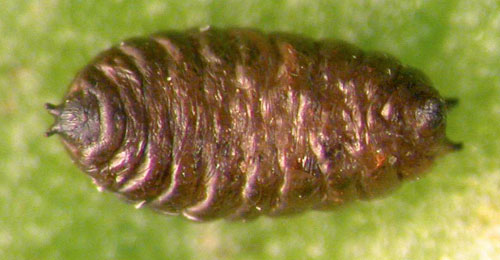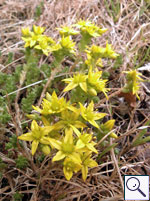|
||||||
|
SEDUM. Stonecrops, Roseroot and Orpine. [Crassulaceae] |
|
|
Twenty-nine species of Sedum are recorded in Britain. These include the native Biting Stonecrop (S. acre), Roseroot (S. rosea) and Orpine (S. telephium) and the introduced Pink Stonecrop (S. cepaea). Six British miners are recorded on Sedum. A key to the European miners recorded on Sedum is provided in Bladmineerders van Europa. |
|
Key for the identification of the known mines of British |
1a > Leaf-miner and web-spinner: Numerous, short, narrow galleries, mainly in the basal half of the leaf. Frass in a central interrupted line. The older larvae live free under a communal web. The larvae initially mine the leaves, making narrow galleries and then feed gregariously in a slight web. |
|
Yponomeuta sedella Treitschke, 1832 [Lepidoptera: Yponomeutidae]. |
1b > Leaf-miner: A shallow, irregularly linear mine which can develop into a secondary blotch (Spencer, 1972b: 90). Pupation internal, the puparium loose in the mine (Spencer, 1976: 494). Upper-surface, whitish (shallow), strongly contorted corridor, that may form a secondary blotch. Frass in a few, widely scattered grains. Pupation mostly within the mine; in front of the brown puparium lies a preformed exit slit. |
 Phytomyza sedicola puparium Image: © Willem Ellis (Bladmineerders van Europa) |
|
Phytomyza sedicola Hering, 1924 [Diptera: Agromyzidae]. |
1c > Leaf-miner: Brownish lower surface blotch. The leaves finally are completely eaten out and turn whitish. Pupation within the mine; the pupariumprium mostly is located in the leaf tip. |
|
Phytomyza sedi Kaltenbach, 1869 [Diptera: Agromyzidae]. |
1d > Leaf-miner: Linear mine, although the maze of galleries formed sometimes appears to form a false blotch. Pupation internal, at the end of the mine or external. |
|
Phytomyza rhodiolae Griffiths, 1976 [Diptera: Agromyzidae]. |
1e > Leaf-miner: Full depth mine; in parts of the mine the parenchyma remain untouched. The larva enters and exits the leaf by means of an oval opening of 3-5 mm at the base, near the leaf edge. Pupation external. Forms a deep mine with plentiful frass. The larva changes leaves entering and leaving near the leaf edge. |
|
Cheilosia semifasciata Becker, 1894 [Diptera: Syrphidae]. |
1f > Leaf-miner: A short, irregular, linear upper surface mine on any part of the leaf. Also recorded from young pods (Bland, 1997a). Long corridor mine. As a rule the first part of the mine is lower-surface, the later part upper-surface. Often the loops are so dense that a secondary blotch is the result. Because upper- and lower-surface corridor segments often cross, the mine obtains a strange array of transparant patches. There is no association with the midrib. Frass in strings and thread fragments. Pupation outside the mine; exit slit in upper epidermis. Mine not associated with the veins or midrib of the leaf (It is this character which enables distinction from another Agromyzid pest species - Liriomyza huidobriensis). The larvae may leave one leaf (if not large enough) and enter another leaf, via the petiole). It exits the leaf to pupate through a semi-circular slit in the upper surface of the leaf. |
|
Liriomyza bryoniae (Kaltenbach, 1858) [Diptera: Agromyzidae]. |
| Last updated 07-Jul-2019 Brian Pitkin | ||

